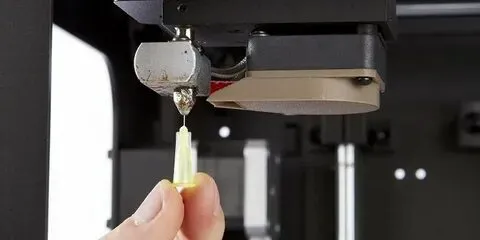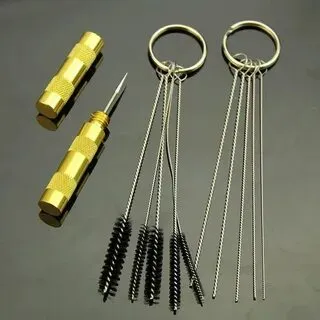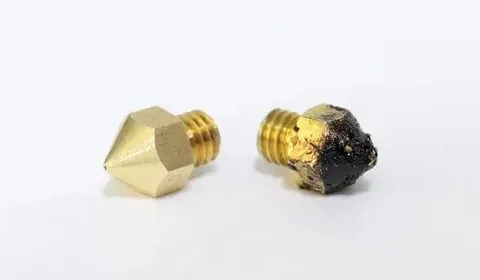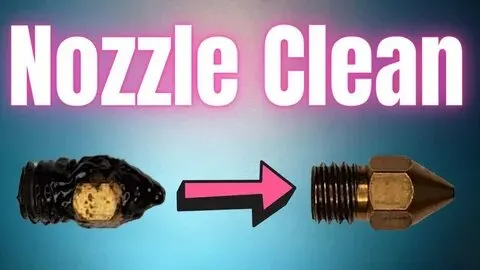A clogged 3D printer nozzle can ruin prints and waste material. Learning how to clean a 3D printer nozzle helps fix poor extrusion, keeps your prints sharp, and extends the life of your printer. Here’s how to clean it safely and easily.
In this guide, we’ll walk you through the safest and most effective ways to clean your 3D printer nozzle step by step
Signs Your 3D Printer Nozzle Needs Cleaning
If your 3D prints have gaps, uneven layers, or the filament isn’t coming out smoothly, your nozzle likely needs cleaning. Clicking sounds, weak extrusion, or no filament flow are also clear signs of a clogged or dirty nozzle.
Inconsistent Filament Flow
Check for tangled filament, partial clogs, or uneven spool tension. Keep the nozzle clean and maintain a steady printing temperature.
Gaps or Under-Extrusion in Prints
Inspect the nozzle for blockages, adjust the print speed, and ensure the filament diameter matches the slicer settings for smooth flow.
Clicking or Grinding Noises from the Extruder
These sounds mean the extruder is stuck or skipping. Clean the gear, check for clogs, and adjust nozzle temperature
Common Causes of Nozzle Clogs in 3D Printers

Dust, cheap filament, or old nozzles often cause 3D printer clogs. Filament melts unevenly, blocking the nozzle. Avoid this by using quality filament, cleaning the nozzle regularly, and not overheating. These steps keep prints smooth and your printer safe.
Printing at Incorrect Temperatures
The wrong temperature can cause clogs or weak prints. Always match filament type with the right heat settings in the slicer.
Low-Quality or Dirty Filament
Cheap or dirty filament causes jams and poor layers. Use good-quality, dry filament and store it in airtight containers.
Dust or Debris Entering the Nozzle
Dust blocks the nozzle and affects the flow. Always use a filament cleaner or sponge and keep your workspace clean.
Tools You Need to Clean a 3D Printer Nozzle Properly
To clean a 3D printer nozzle properly, you’ll need a needle or unclogging tool to clear blockages, a brass brush for scrubbing off melted filament, heat-resistant gloves for safety, and cleaning filament or acetone (for brass nozzles) to remove stubborn residue. Always heat the nozzle before cleaning for best results.
How to Perform Cold Pull Cleaning Step-by-Step
You must first heat your nozzle to normal printing temperature before performing a cold pull. Clean filament (Nylon works best) should be pushed through until it flows smoothly. It should be warm, but not hot, when the nozzle reaches 90°C. Once the filament is firmly pulled out, remove it from the machine. Stuck debris will stick to the filament. Repeat 2-3 times until the filament comes out clean. This method safely removes clogs without tools by using the filament itself to pull out contaminants. Works great for PLA, PETG, and other common filaments!
Using Needles and Brushes for Precise Nozzle Cleaning

To clear clogged nozzles, use thin needles and soft brushes. Deep cleaning is ensured with this combo. Regular maintenance prevents print issues by keeping ink flowing smoothly. It is simple, effective, and safe for long-term nozzle health.
How to Use Heat to Unclog a 3D Printer Nozzle Safely
Heat the nozzle to its printing temperature (usually 200°C+). Let the melted filament ooze out, then gently push the remaining residue with a cleaning needle or brass brush. Avoid excessive force—let heat do the work. Cool down before wiping for safe, effective unclogging.
Also read must: Can I Get Boudoir Photos Printed At Walgreens-Get Answers!
Cleaning with Solvents: What’s Safe and Effective
Use isopropyl alcohol (90% or higher) or printer-safe cleaning fluid to clean nozzles. Avoid harsh chemicals like acetone or bleach. Apply gently with a lint-free cloth or syringe. These safe solvents remove dried ink without damaging delicate parts.
How to Remove and Deep Clean the Nozzle Manually
To remove and deep clean the nozzle manually, first unplug the printer. Take out the cartridge, then gently detach the nozzle. Soak it in warm water for 30 minutes. Use a soft brush or cloth to clean it, then dry completely.
Preventing Nozzle Clogs: Pro Tips for Long-Term Care

To prevent nozzle clogs, print at least once a week, always use good-quality ink, and keep the printer in a dust-free place. Turn it off properly after use. Clean the nozzles monthly to keep them smooth and working well.
How to Identify
To identify a clogged nozzle, check for faded, streaky, or missing lines in prints. Run a nozzle check from the printer settings. If the pattern looks broken or uneven, it means the nozzle is blocked and needs cleaning.
How to Avoid
To avoid nozzle clogs, use the printer regularly, even once a week. Always use high-quality ink and store cartridges properly. Keep the printer clean and away from dust. Never leave empty cartridges inside, and shut down the printer correctly.
How to Clean
To clean a printer nozzle, remove the cartridge and gently wipe the nozzle with a lint-free cloth soaked in warm water or isopropyl alcohol. Let it dry fully before reinstalling. This clears dried ink and restores smooth printing.
Why It Happens
Nozzle clogs happen when ink dries inside the nozzle due to long gaps between prints, low-quality ink, or dust buildup. Heat, air exposure, or leaving cartridges empty too long can also block the tiny openings and stop smooth printing.
Faqs
How often should I clean my 3D printer nozzle?
You should clean the nozzle monthly or whenever print quality drops.
What’s the safest solvent to use for cleaning nozzles?
Isopropyl alcohol (90% or higher) is safe and effective for cleaning nozzles.
How can I prevent nozzle clogs during long breaks?
Print at least once a week and store filament in a dry, dust-free place.
What are common signs of a clogged nozzle?
Look for gaps in prints, inconsistent filament flow, or clicking noises from the extruder.
Why is printing at the correct temperature important?
Incorrect temperature causes poor flow, clogging, and weak print layers.
conclusion
To keep your 3D printer running smoothly, regular nozzle care is key. Use the right temperature, clean with safe solvents, and store quality filament properly. Prevent clogs by printing often, keeping dust away, and spotting early signs like noise or under-extrusion. Simple habits and careful maintenance can save time, improve print quality, and extend your printer’s life.
